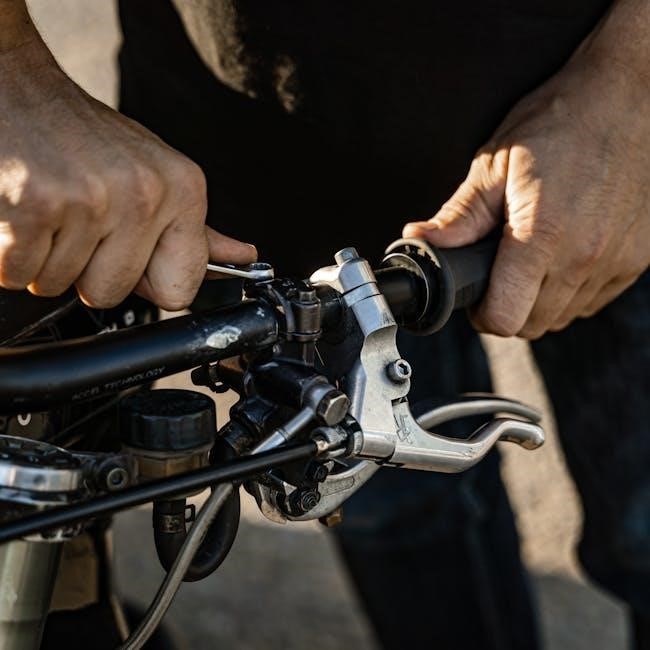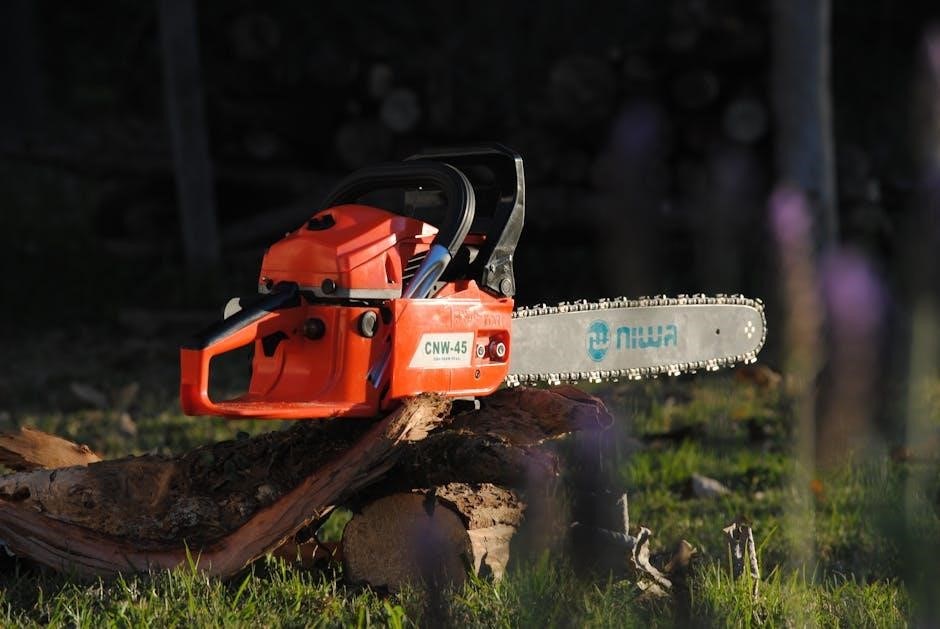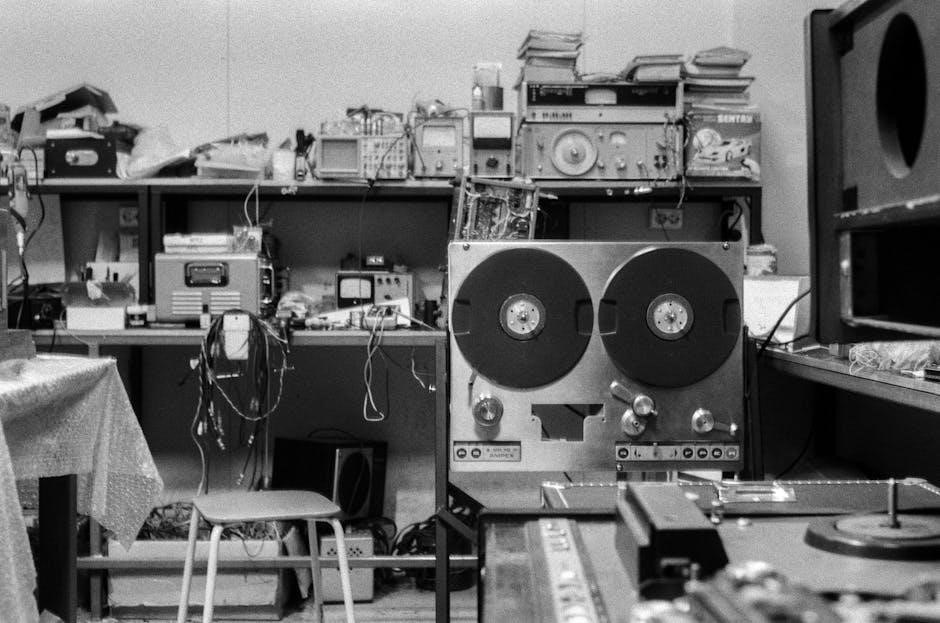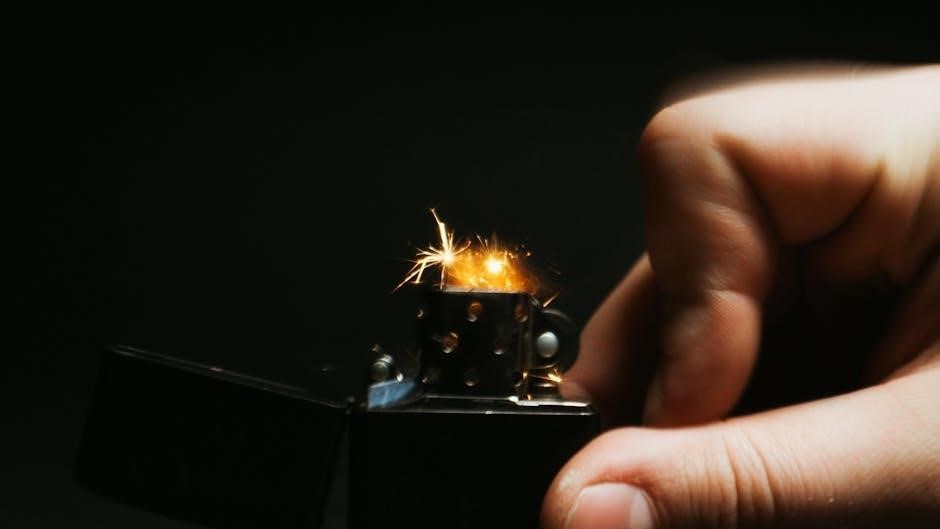Manual clutches for small engines offer effective and reliable power control. They are easy to install, low maintenance, and provide smooth engagement, making them ideal for various small engine applications.
Overview of Manual Clutches
A manual clutch is a mechanical component used to engage and disengage power transmission between a small engine and its driven components. It operates by connecting and disconnecting the engine’s flywheel from the transmission, allowing smooth starts, stops, and gear shifts. Manual clutches are designed to be user-controlled, typically via a pedal or lever, and are widely used in small vehicles, motorcycles, and industrial machinery. They are known for their simplicity, reliability, and ease of installation. The clutch system consists of a pressure plate, clutch disc, and release bearing, working together to transfer power efficiently. With proper maintenance, manual clutches provide consistent performance and durability, making them a popular choice for small engine applications. Their versatility and effectiveness have solidified their role in various industries, from automotive to agricultural equipment.
Importance of Manual Clutches in Small Engines
Manual clutches play a crucial role in small engines by enabling precise control over power transmission. They allow smooth engagement and disengagement of the engine’s power, ensuring efficient starts, stops, and speed adjustments. This capability is essential for maintaining optimal performance and preventing damage to the engine or connected components. Manual clutches also enhance operational safety by providing drivers with direct control, especially in challenging conditions. Their reliability and efficiency make them a cornerstone in small vehicles, motorcycles, and industrial equipment. Additionally, manual clutches are cost-effective and require minimal maintenance, further solidifying their importance in small engine applications. By facilitating seamless power transfer, they contribute to the overall durability and functionality of the engine system, making them an indispensable component for both everyday use and specialized machinery.

Basic Components of a Manual Clutch System
A manual clutch system for small engines typically consists of several key components. The flywheel is mounted on the engine crankshaft and provides a smooth surface for the clutch to engage. The clutch disc, often equipped with a splined hub, connects to the transmission input shaft and engages with the flywheel. The pressure plate applies the necessary force to hold the clutch disc against the flywheel, ensuring proper engagement. A throw-out bearing or release bearing is used to disengage the clutch when the pedal is pressed. Additionally, a clutch cable or hydraulic system connects the clutch pedal to the release mechanism, enabling driver control. These components work together to facilitate smooth and efficient power transfer between the engine and transmission, allowing for precise control during acceleration, deceleration, and gear changes.

Applications of Manual Clutches for Small Engines
Manual clutches are widely used in small vehicles, motorcycles, and industrial machinery. They are also applied in agricultural equipment, providing reliable and efficient power control for various small engine applications.
Use in Small Vehicles and Motorcycles
Manual clutches are extensively used in small vehicles and motorcycles to provide precise control over power delivery. They enable smooth engagement and disengagement of the engine, enhancing driving experience and efficiency. In motorcycles, manual clutches are essential for seamless gear shifts, allowing riders to manage acceleration and deceleration effectively. Similarly, in small vehicles, they offer reliable performance, especially in city driving conditions where frequent stopping and starting are common. The compact design and low maintenance requirements of these clutches make them ideal for such applications. Additionally, manual clutches in small engines are often paired with dry disc or centrifugal systems, which are lightweight and easy to install. Their efficiency and durability contribute to their popularity among enthusiasts and manufacturers alike, ensuring optimal power transfer and control in various mobility solutions.
Applications in Industrial Machinery
Manual clutches play a crucial role in industrial machinery, where precise control over power transmission is essential. They are widely used in applications such as conveyor systems, machine tools, and material handling equipment. These clutches enable smooth engagement and disengagement of machinery components, ensuring efficient operation and reducing wear on equipment. In industrial settings, manual clutches are often preferred for their reliability and ease of installation. They are particularly effective in scenarios where frequent start-stop operations are required, as they provide consistent and predictable power transfer. Additionally, manual clutches in industrial machinery are designed to withstand heavy-duty cycles, making them a durable solution for demanding environments. Their low maintenance requirements further enhance their appeal in industrial applications, where downtime must be minimized to maintain productivity.

Role in Agricultural Equipment
Manual clutches are integral to agricultural equipment, enabling precise control over power delivery in demanding environments. They are commonly used in tractors, harvesters, and tillers to facilitate smooth engagement and disengagement of machinery components. This functionality is crucial for operations like plowing, sowing, and harvesting, where consistent power transfer is essential. Manual clutches in agricultural equipment allow operators to manage heavy-duty cycles efficiently, reducing wear on machinery and enhancing productivity. Their durability and low maintenance requirements make them ideal for rugged agricultural settings. Additionally, manual clutches provide operators with better control over equipment, ensuring accurate and efficient performance in the field. This reliability has solidified their role as a critical component in modern agricultural machinery.
Types of Manual Clutches for Small Engines
Manual clutches for small engines include centrifugal, dry disc, and wet disc types, each offering distinct advantages in power transfer and durability for specific applications.
Centrifugal Clutches
Centrifugal clutches are a popular choice for small engines due to their simplicity and efficiency. They operate by using centrifugal force to engage the clutch when the engine reaches a specific RPM, ensuring smooth power transfer. These clutches are relatively low maintenance, easy to install, and provide consistent performance. They are ideal for applications where automatic engagement is desired, such as in go-karts, scooters, and small recreational vehicles. The design allows for easy adjustment of the engagement point, making them versatile for various power delivery needs. Centrifugal clutches are also known for their durability and reliability, offering a cost-effective solution for small engine enthusiasts. Their compact size and lightweight construction further enhance their appeal in applications where space and weight are critical factors.
Dry Disc Clutches
Dry disc clutches are a popular choice for small engines, offering reliable and efficient power transfer. They consist of a pressure plate, clutch disc, and flywheel, operating in a dry environment without lubrication. This design makes them lightweight and compact, ideal for applications where space is limited. Dry disc clutches are known for their smooth engagement and disengagement, providing precise control over power delivery. They are commonly used in small vehicles, motorcycles, and agricultural equipment due to their ease of installation and minimal maintenance requirements. The dry disc clutch is also adaptable, allowing for customization to suit specific engine specifications. Their durability and cost-effectiveness make them a preferred option for small engine enthusiasts seeking a dependable manual clutch system. Overall, dry disc clutches deliver consistent performance and are well-suited for a variety of small engine applications.
Wet Disc Clutches
Wet disc clutches are a durable and efficient option for small engines, operating in a lubricated environment. This design reduces wear and tear, extending the clutch’s lifespan. They are commonly used in industrial and agricultural equipment, where consistent power transfer and cooling are essential. Wet disc clutches are less prone to overheating compared to dry disc clutches, making them ideal for high-stress applications. However, they are slightly heavier and more complex to install due to the need for lubrication. Despite this, their reliability and longevity make them a preferred choice for demanding small engine operations. Wet disc clutches provide smooth engagement and disengagement, ensuring optimal performance in challenging conditions. Their ability to handle heavy loads and maintain consistent power delivery makes them a versatile solution for various small engine applications.

Installation of Manual Clutches for Small Engines
Installing a manual clutch for small engines requires precise alignment and securement. Ensure proper flywheel specifications, clean surfaces, and correct bolt torque. Post-installation testing is essential for smooth operation.
Pre-Installation Checks and Requirements
Before installing a manual clutch for a small engine, ensure the flywheel housing and flywheel meet specified dimensions to prevent premature wear. Remove the old pilot bearing and clean all contact surfaces thoroughly. Use a dial indicator to check flywheel and housing runout, ensuring they are within acceptable tolerances. Inspect the shaft for damage or wear and verify the clutch kit compatibility with the engine’s specifications. Proper alignment and securement are critical for smooth operation. Always refer to the manufacturer’s guidelines for specific requirements and torque values. Failure to meet these standards can lead to inefficient power transfer or clutch failure. Proper preparation ensures a reliable and durable clutch system.

Step-by-Step Installation Process
Begin by removing the old clutch cover and components, taking care to release the brake spring and loosen the rear brake adjuster. Install the new pilot bearing and ensure it is securely seated. Next, place the clutch disc onto the flywheel, aligning it properly. Install the pressure plate and tighten the bolts evenly to avoid warping. Replace the clutch cover and reconnect the clutch cable, adjusting it to achieve the correct free play. Tighten all bolts to the manufacturer’s specified torque values. Finally, test the clutch by engaging and disengaging it several times to ensure smooth operation. Proper alignment and securement are critical for optimal performance. Follow the manufacturer’s instructions for precise steps and torque specifications to guarantee a reliable installation.
Post-Installation Testing and Adjustments
After installing the manual clutch, perform a series of tests to ensure proper function. Start by engaging and disengaging the clutch several times to check for smooth operation. Adjust the clutch cable to achieve the correct free play, ensuring it is not too loose or tight. Test the clutch under load to verify consistent power transfer and smooth engagement. Inspect for any signs of drag or slippage, which may indicate improper alignment or worn components. Fine-tune the clutch adjustment to optimize performance and prevent premature wear. Refer to the manufacturer’s specifications for torque values and adjustment procedures. Proper testing and adjustments are crucial for ensuring reliable operation and extending the lifespan of the clutch system.
Maintenance and Care of Manual Clutches
Regular cleaning and lubrication of clutch components are essential for smooth operation. Inspect for wear and tear, and replace worn parts promptly to prevent premature failure and ensure optimal performance.
Cleaning and Lubrication
Cleaning and lubrication are critical for maintaining the performance and longevity of a manual clutch in small engines. Regularly inspect and clean the flywheel housing and flywheel to ensure surfaces are free from dirt and debris. Use a dial indicator to check for any irregularities or wear, as improper alignment can lead to premature clutch failure. Lubricate moving parts, such as the pilot bearing, with a high-quality grease to reduce friction and wear. Avoid over-lubrication, as it can attract dust and contaminants. Always clean the clutch components before reassembly and ensure all surfaces are dry and free of old lubricant. Proper cleaning and lubrication practices help maintain smooth clutch engagement and prevent unnecessary wear on the system.
Inspecting for Wear and Tear
Inspecting for wear and tear on a manual clutch for small engines is essential to ensure optimal performance and prevent premature failure; Start by examining the flywheel housing and flywheel for cracks, scoring, or excessive wear. Use a dial indicator to measure the flywheel’s surface for runout, ensuring it meets specifications. Check the pilot bearing for smooth operation and freedom from play. Inspect the clutch disc for excessive wear, warping, or damage to the friction material. Look for signs of overheating, such as discoloration or glazing on the flywheel or disc. Also, verify that the clutch cable or lever operates smoothly without binding. Regular inspections help identify issues early, allowing for timely repairs and preventing costly damage to the engine or transmission.
Replacing Worn-Out Components
Replacing worn-out components of a manual clutch for small engines is crucial for maintaining performance and preventing further damage. Start by removing the old clutch components, including the pilot bearing, clutch disc, and pressure plate. Inspect the flywheel for damage or wear and resurface it if necessary. Install a new pilot bearing, ensuring it is properly seated and aligned. Next, mount the new clutch disc and pressure plate, making sure they are securely fastened. Use a dial indicator to verify the flywheel’s surface meets specifications for proper clutch engagement. Finally, reconnect the clutch cable or lever, adjusting it to achieve the correct free play. Always use high-quality replacement parts that meet or exceed manufacturer specifications to ensure reliability and longevity of the clutch system.

Troubleshooting Common Issues
Identify symptoms like slipping or dragging, then inspect components such as the flywheel, pilot bearing, and clutch disc for wear or misalignment. Adjust or replace parts as needed.
Identifying Common Problems
Common issues with manual clutches for small engines include slipping, dragging, or noisy operation. Slipping occurs when the clutch fails to engage properly, often due to worn friction material or misalignment. Dragging happens when the clutch does not disengage fully, typically caused by a faulty pilot bearing or incorrect adjustment. Noisy operation, such as grinding or squealing, may indicate worn components or improper installation. Regular inspection of the flywheel, clutch disc, and pressure plate is essential to identify wear or damage. Additionally, checking the clutch cable or lever for proper alignment and tension can help diagnose issues. Early detection of these problems prevents further damage and ensures smooth engine performance. Addressing these issues promptly is crucial for maintaining the efficiency and longevity of the clutch system.
Diagnosing Clutch Failure
Diagnosing clutch failure in small engines involves a systematic approach to identify the root cause. First, inspect the flywheel housing and flywheel for specifications, as deviations can lead to premature wear. Use a dial indicator to measure flywheel runout and ensure all surfaces are clean and dry. Check the pilot bearing for proper fitment and operation. Inspect the clutch disc, pressure plate, and flywheel for signs of wear, such as scoring, warping, or excessive glazing. Test the clutch cable or lever for smooth actuation and proper alignment. If the clutch slips or engages unevenly, it may indicate worn friction material or misalignment. Noisy operation, such as grinding or squealing, often points to damaged or improperly installed components. Addressing these issues early prevents further damage and ensures reliable engine performance. Regular maintenance and accurate diagnostics are key to extending the life of the clutch system.
Repair and Replacement Tips
When repairing or replacing a manual clutch for a small engine, start by inspecting all components for wear or damage. Replace the clutch disc, pressure plate, and flywheel if they show signs of scoring, warping, or excessive glazing. Ensure the pilot bearing is properly fitted and functioning smoothly. Use a dial indicator to check flywheel runout and ensure it meets specifications. Clean and lubricate all moving parts, such as the clutch cable and actuation arm, to ensure smooth operation. When installing a new clutch, align the clutch disc correctly with the flywheel and pressure plate. Tighten bolts gradually and evenly to avoid warping. After installation, test the clutch engagement by actuating the lever multiple times to ensure proper function. Always follow the manufacturer’s guidelines for torque specifications and replacement procedures to guarantee reliability and performance.
Performance Optimization of Manual Clutches
Optimizing manual clutches for small engines involves enhancing efficiency, smooth engagement, and durability. Proper installation, regular maintenance, and fine-tuning clutch settings ensure maximum power transfer and minimize wear on components.

Enhancing Power Transfer Efficiency

Enhancing power transfer efficiency in manual clutches for small engines involves optimizing clutch design and maintenance. Centrifugal clutches, for instance, provide smooth and consistent power delivery by automatically engaging based on engine speed. Proper installation ensures alignment with the flywheel, reducing wear and improving torque transfer. Regular cleaning and lubrication of components, such as the clutch cable and pivot points, minimize friction and ensure precise engagement. Additionally, using high-quality materials, like durable friction discs, enhances grip and reduces slippage. Fine-tuning the clutch’s engagement point and adjusting the cable tension can also improve responsiveness. By addressing these factors, users can maximize the efficiency of their manual clutch system, ensuring reliable performance and extended component lifespan.

Improving Clutch Durability
Improving clutch durability for small engines requires careful maintenance and proper usage. Regular cleaning of the clutch components, such as the friction disc and pressure plate, prevents dust and debris buildup that can cause premature wear. Lubricating pivot points and cables ensures smooth operation and reduces friction-related damage. Avoiding aggressive acceleration and sudden clutch engagement can extend the lifespan of the clutch. Additionally, using high-quality materials, such as durable friction discs, enhances resistance to wear and tear. Proper installation and alignment of the clutch with the flywheel are also critical to prevent uneven stress. Monitoring for signs of wear, such as slippage or noise, and addressing issues promptly can further improve longevity. By following these practices, users can significantly extend the service life of their manual clutch system.
Fine-Tuning Clutch Engagement
Fine-tuning clutch engagement is crucial for optimal performance in small engines. Proper adjustment ensures smooth power delivery and precise control. Start by adjusting the clutch cable to achieve the correct free play, typically 1/8 inch, to prevent premature wear. Next, ensure the clutch lever or pedal is positioned for comfortable operation, allowing for a full range of motion. Use a feeler gauge to check the gap between the clutch disc and pressure plate when disengaged, ensuring it matches manufacturer specifications. Additionally, inspect and clean the clutch components to eliminate any drag or resistance. Fine-tuning the engagement point by adjusting the cable or lever can enhance responsiveness, making it easier to control the engine’s power output. Regular adjustments and inspections help maintain consistent performance and prevent issues like slippage or hesitation.
Manual clutches for small engines are reliable, efficient, and low maintenance, making them a popular choice for enthusiasts. They offer smooth power transfer and are easy to install and adjust.
Manual clutches for small engines are essential for controlling power delivery, offering reliability and efficiency. They are widely used in small vehicles, motorcycles, industrial machinery, and agricultural equipment. These clutches are low maintenance, easy to install, and provide smooth engagement. Centrifugal, dry disc, and wet disc clutches cater to different applications, ensuring optimal performance. Proper installation, regular maintenance, and timely inspections are crucial for longevity. Troubleshooting common issues and replacing worn components can prevent premature wear. By enhancing power transfer efficiency and durability, manual clutches remain a vital component for small engine systems, delivering consistent and controlled power output across various industries.
Future Trends in Manual Clutch Technology
Future trends in manual clutch technology for small engines focus on enhancing efficiency, durability, and adaptability. Advances in materials science will lead to lighter, stronger components, improving power transfer and reducing wear. Automated clutch systems may emerge, offering smarter engagement based on engine speed and load. Integration with electronic controls could optimize performance in varying conditions. Additionally, modular designs will simplify installation and customization for different applications. Manufacturers are also exploring eco-friendly materials and energy-efficient solutions to align with sustainability goals. These innovations aim to maintain the reliability of manual clutches while addressing modern demands for performance, ease of use, and environmental responsibility.
Final Thoughts on Manual Clutches for Small Engines
Manual clutches for small engines remain a reliable and efficient solution for controlling power delivery. Their ease of installation, low maintenance, and smooth engagement make them a popular choice for enthusiasts and professionals alike. With advancements in materials and design, these clutches continue to offer durability and versatility across various applications. Whether for small vehicles, industrial machinery, or agricultural equipment, manual clutches provide consistent performance and adaptability. Their ability to enhance power transfer while maintaining simplicity ensures they remain a vital component in small engine systems. As technology evolves, manual clutches are likely to retain their relevance, offering a balance of tradition and innovation for years to come.